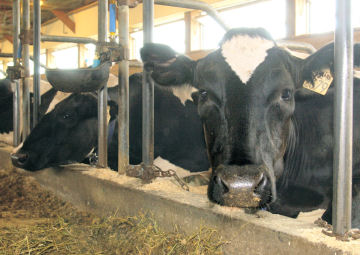Cloned Meat and Milk Are Safe, but They Won’t Hit Stores Soon
- More than 2 years ago
After years of analysis, the Food and Drug Administration has concluded that animal clones and their products are safe to eat. But don’t expect to see steaks and yogurt from copied cows or other animals on grocery shelves anytime soon. Besides the years-long time investment it takes to create such animals, the expense and “yuck factor” in many consumers’ minds may make cloned foods a tough sell, say some researchers.

Cloned animals are genetic copies of each other. While nature produces clones—in the form of identical twins—scientists have been in the business of making copies of adult animals since Dolly the sheep was born in 1996. In that experiment, researchers at the Roslin Institute in Scotland slipped the nucleus of a cell from an adult-female sheep into another sheep’s egg that had had its own nucleus removed. By electrically shocking this egg, the researchers prompted the altered egg cell to divide and eventually form a lamb with the same set of genes as the sheep that contributed the adult cell.
Researchers have since used similar techniques to clone a variety of animals ranging from common ones, such as cows, horses, and dogs, to more exotic species, such as a cowlike animal called a guar. But all along, notes Steve Stice of the University of Georgia in Athens, cloning researchers’ primary focus has been on agricultural animals. Stice’s own team has cloned hundreds of cattle and pigs in the past several years.
Making genetic copies of a prize cow, pig, or sheep can preserve the animals’ best qualities—the juiciest meat, the most milk, or the softest wool—while avoiding the guesswork and chance involved in conventional breeding, adds Robert Lanza, vice president of research and scientific development at Advanced Cell Technology. The company, which now focuses on generating human stem cells for medical purposes, was started as an agricultural-cloning company.
Lanza notes that even though the vast majority of cloned animals are healthy, some clones suffer from problems that researchers still don’t quite understand. For example, some clones seem to age early, become obese, or have weakened immune systems.
“These cloning glitches have fueled the public’s fear” that clones might be unsafe in the food supply, says Lanza.
With efforts to clone agricultural animals well under way at numerous research institutions and private companies, FDA did a lengthy examination of existing cloning data. In a 678-page analysis entitled “Animal Cloning: A Draft Risk Assessment” released Dec. 28, 2006, the agency concludes that no significant difference exists between the meat and milk of clones and their naturally conceived counterparts. Therefore, eating clones or their products is no riskier to people’s health than eating food from any animal, the agency asserts.
“Based on FDA’s analysis of hundreds of peer-reviewed publications and other studies on the health and food composition of clones and their offspring, the draft risk assessment has determined that meat and milk from clones and their offspring are as safe as food we eat every day,” says Stephen F. Sundlof, director of FDA’s Center for Veterinary Medicine.
Additionally, Sundlof notes, improved cloning techniques have greatly reduced the risk that cloned animals will have health problems. “Cloning poses no unique risks to animal health when compared to other assisted reproductive technologies currently in use in U.S. agriculture,” he adds.
Though the analysis states that its conclusions are firm, FDA has set the next 90 days as a period for public comment. Officials promise to consider the comments when setting a policy on how industry should use cloned animals.
Even if FDA eventually sends in the clones to grocery stores, it’s unlikely that the public will be eager to buy this food, says Michael Fernandez of the Washington, D.C.–based Pew Initiative on Food and Biotechnology, an independent group that collects information on agricultural biotechnology. In a poll of 1,000 consumers that the group released on Dec. 6, 2006, 61 percent said that they were “uncomfortable” with animal cloning.
“We don’t know exactly why the public is uncomfortable,” says Fernandez. “People might have ethical and religious-based concerns, or there might be some discomfort with the idea of new technology. It could be a mix of things.”
Despite this psychological sticking point, another barrier to consuming clones is their substantial cost, says Lanza. “Cloned animals can cost tens of thousands of dollars to produce. That would be the most expensive hamburger on the planet.”
The most plausible use of clones for the foreseeable future, notes Lanza, is as breeding stock for reproducing desired traits in agricultural animals the old-fashioned way.
“We’re probably not going to be making cheeseburgers out of clones anytime soon,” he says.






